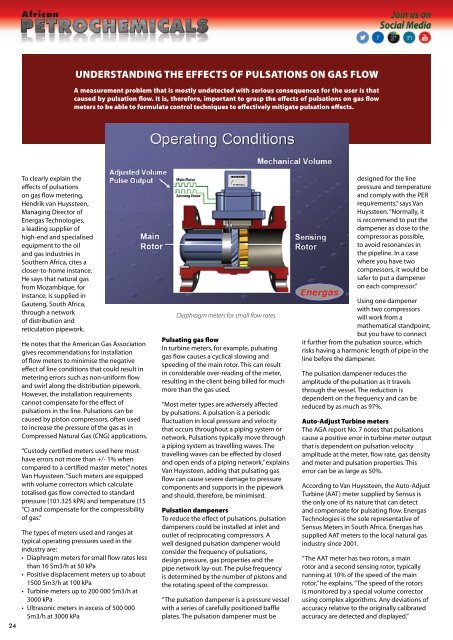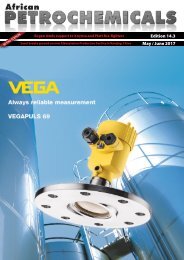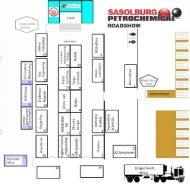African Petrochemicals May/June Edition 15.3 {2018}
Create successful ePaper yourself
Turn your PDF publications into a flip-book with our unique Google optimized e-Paper software.
UNDERSTANDING THE EFFECTS OF PULSATIONS ON GAS FLOW<br />
A measurement problem that is mostly undetected with serious consequences for the user is that<br />
caused by pulsation flow. It is, therefore, important to grasp the effects of pulsations on gas flow<br />
meters to be able to formulate control techniques to effectively mitigate pulsation effects.<br />
24<br />
To clearly explain the<br />
effects of pulsations<br />
on gas flow metering,<br />
Hendrik van Huyssteen,<br />
Managing Director of<br />
Energas Technologies,<br />
a leading supplier of<br />
high-end and specialised<br />
equipment to the oil<br />
and gas industries in<br />
Southern Africa, cites a<br />
closer-to-home instance.<br />
He says that natural gas<br />
from Mozambique, for<br />
instance, is supplied in<br />
Gauteng, South Africa,<br />
through a network<br />
of distribution and<br />
reticulation pipework.<br />
He notes that the American Gas Association<br />
gives recommendations for installation<br />
of flow meters to minimise the negative<br />
effect of line conditions that could result in<br />
metering errors such as non-uniform flow<br />
and swirl along the distribution pipework.<br />
However, the installation requirements<br />
cannot compensate for the effect of<br />
pulsations in the line. Pulsations can be<br />
caused by piston compressors, often used<br />
to increase the pressure of the gas as in<br />
Compressed Natural Gas (CNG) applications.<br />
“Custody certified meters used here must<br />
have errors not more than +/- 1% when<br />
compared to a certified master meter,” notes<br />
Van Huyssteen. “Such meters are equipped<br />
with volume correctors which calculate<br />
totalised gas flow corrected to standard<br />
pressure (101.325 kPA) and temperature (15<br />
°C) and compensate for the compressibility<br />
of gas.”<br />
The types of meters used and ranges at<br />
typical operating pressures used in the<br />
industry are:<br />
• Diaphragm meters for small flow rates less<br />
than 16 Sm3/h at 50 kPa<br />
• Positive displacement meters up to about<br />
1500 Sm3/h at 100 kPa<br />
• Turbine meters up to 200 000 Sm3/h at<br />
3000 kPa<br />
• Ultrasonic meters in excess of 500 000<br />
Sm3/h at 3000 kPa<br />
Diaphragm meters for small flow rates.<br />
Pulsating gas flow<br />
In turbine meters, for example, pulsating<br />
gas flow causes a cyclical slowing and<br />
speeding of the main rotor. This can result<br />
in considerable over-reading of the meter,<br />
resulting in the client being billed for much<br />
more than the gas used.<br />
“Most meter types are adversely affected<br />
by pulsations. A pulsation is a periodic<br />
fluctuation in local pressure and velocity<br />
that occurs throughout a piping system or<br />
network. Pulsations typically move through<br />
a piping system as travelling waves. The<br />
travelling waves can be effected by closed<br />
and open ends of a piping network,” explains<br />
Van Huyssteen, adding that pulsating gas<br />
flow can cause severe damage to pressure<br />
components and supports in the pipework<br />
and should, therefore, be minimised.<br />
Pulsation dampeners<br />
To reduce the effect of pulsations, pulsation<br />
dampeners could be installed at inlet and<br />
outlet of reciprocating compressors. A<br />
well designed pulsation dampener would<br />
consider the frequency of pulsations,<br />
design pressure, gas properties and the<br />
pipe network lay-out. The pulse frequency<br />
is determined by the number of pistons and<br />
the rotating speed of the compressor.<br />
“The pulsation dampener is a pressure vessel<br />
with a series of carefully positioned baffle<br />
plates. The pulsation dampener must be<br />
designed for the line<br />
pressure and temperature<br />
and comply with the PER<br />
requirements,” says Van<br />
Huyssteen. “Normally, it<br />
is recommend to put the<br />
dampener as close to the<br />
compressor as possible,<br />
to avoid resonances in<br />
the pipeline. In a case<br />
where you have two<br />
compressors, it would be<br />
safer to put a dampener<br />
on each compressor.”<br />
Using one dampener<br />
with two compressors<br />
will work from a<br />
mathematical standpoint,<br />
but you have to connect<br />
it further from the pulsation source, which<br />
risks having a harmonic length of pipe in the<br />
line before the dampener.<br />
The pulsation dampener reduces the<br />
amplitude of the pulsation as it travels<br />
through the vessel. The reduction is<br />
dependent on the frequency and can be<br />
reduced by as much as 97%.<br />
Auto-Adjust Turbine meters<br />
The AGA report No. 7 notes that pulsations<br />
cause a positive error in turbine meter output<br />
that is dependent on pulsation velocity<br />
amplitude at the meter, flow rate, gas density<br />
and meter and pulsation properties. This<br />
error can be as large as 50%.<br />
According to Van Huyssteen, the Auto-Adjust<br />
Turbine (AAT) meter supplied by Sensus is<br />
the only one of its nature that can detect<br />
and compensate for pulsating flow. Energas<br />
Technologies is the sole representative of<br />
Sensus Meters in South Africa. Energas has<br />
supplied AAT meters to the local natural gas<br />
industry since 2001.<br />
“The AAT meter has two rotors, a main<br />
rotor and a second sensing rotor, typically<br />
running at 10% of the speed of the main<br />
rotor,” he explains. “The speed of the rotors<br />
is monitored by a special volume corrector<br />
using complex algorithms. Any deviations of<br />
accuracy relative to the originally calibrated<br />
accuracy are detected and displayed.”

















